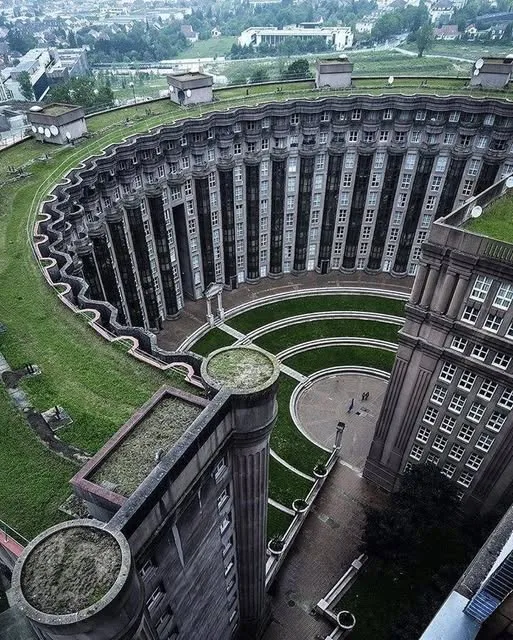Nestled in the suburban landscape of Noisy-le-Grand, just east of Paris, lies Les Espaces d’Abraxas, a striking housing estate completed in 1982. Designed by the visionary architect Ricardo Bofill and his firm Ricardo Bofill Taller de Arquitectura, this complex stands as a bold testament to postmodern architecture and a unique experiment in urban living. This blog post delves into the history, design, and cultural significance of this “inhabited monument,” exploring its rise, challenges, and enduring legacy.

A Vision of the Future
Les Espaces d’Abraxas was born out of a French government initiative in the mid-20th century to create five “New Towns” around Paris, addressing the housing shortages and urban sprawl following World War II. Completed in 1982, the estate was envisioned as a self-contained community, blending residential living with monumental architecture. The complex comprises 591 apartments spread across three distinct structures: Le Palacio (441 units), Le Théâtre (130 units), and L’Arc (20 units). Constructed using prefabricated concrete—a nod to modern efficiency—the design draws inspiration from classical architecture, featuring grand arches, columns, and theatrical flourishes.
Bofill’s ambition was to create more than just housing; he aimed for an “inhabited monument” that would foster a sense of community and grandeur. The result is a surreal landscape of towering facades and open plazas, where the past and future collide in a striking visual harmony.
Architectural Innovation
The estate’s postmodern style sets it apart, merging classical motifs with contemporary materials. Le Palacio, the largest structure, resembles a Roman palace with its sweeping arches and symmetrical layout, while Le Théâtre evokes an ancient amphitheater with its curved, stage-like design. L’Arc, a smaller but equally dramatic archway, serves as a gateway to the complex. The use of concrete, painted in earthy tones, adds a raw, industrial edge, contrasting with the ornate details that pay homage to historical architecture.
This bold aesthetic has earned Les Espaces d’Abraxas both praise and criticism. Architectural enthusiasts admire its originality, while some residents have found its scale and design overwhelming. Nonetheless, its uniqueness has made it a cultural icon, featured in films like Brazil (1985) and The Hunger Games: Mockingjay – Part 2 (2015), where its dystopian ambiance added depth to the storytelling.
Challenges and Evolution
Despite its architectural acclaim, Les Espaces d’Abraxas has faced significant challenges. Social issues, including economic disparities and maintenance difficulties, have plagued the estate over the decades. The grand design, while visually impressive, proved costly to upkeep, leading to debates about its future. In recent years, there have been proposals to demolish parts of the complex, sparking controversy among preservationists who see it as a vital piece of architectural heritage.
However, hope remains on the horizon. Recent efforts have shifted toward renovation, with plans to modernize the apartments and improve living conditions while preserving Bofill’s original vision. This ongoing evolution reflects a broader recognition of the estate’s cultural and historical value.
Visiting Les Espaces d’Abraxas
For those intrigued by this architectural marvel, Les Espaces d’Abraxas is easily accessible from Paris via the RER A train to Noisy-le-Grand-Mont d’Est station, a short ride from the city center. While it remains a residential area, visitors can explore the public spaces and admire the exterior design. Guided tours are occasionally offered by architectural organizations, providing deeper insight into Bofill’s intent and the estate’s history. As of Wednesday, July 02, 2025, the site continues to draw interest, especially with ongoing restoration projects.
Conclusion
Les Espaces d’Abraxas stands as a fascinating chapter in the story of modern architecture, a bold experiment that blends the grandeur of the past with the needs of the present. Though it has faced trials, its enduring presence near Paris serves as a reminder of the power of visionary design. Whether viewed as a cinematic backdrop or a living community, this postmodern masterpiece invites us to reconsider the possibilities of urban living and the legacy of those who dare to dream big.





